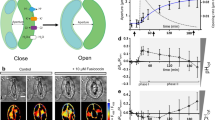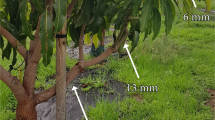Abstract
STOMATAL movements result from turgor imbalances occurring within the stomatal complex which are largely brought about by differential potassium distribution between the guard cells and adjacent epidermal cells1–4. The guard cell vacuole has been established as the sink of the potassium flux during stomatal opening5,6, but the source of the ions has not been identified. It is generally believed that the ion flux is apoplastic because plasmodesmata have only occasionally been observed between the guard and adjacent epidermal cells7–9. We have described substomatal ion-adsorbent sites in some species of filicopsid ferns and Commelinaceae which we believe could act as the immediate sink/source of potassium ions involved in stomatal closing and opening11. Discrete accumulations of Macallum's stain for potassium12 were demonstrated at both poles of the guard cell complex on the face adjacent to the mesophyll. These sites corresponded to substomatal endocuticular swellings observed by scanning electron microscopy which, when collapsed, revealed the presence of a disk-shaped structure on the outer face of the guard cell walls at the site of ion adsorption. Direct observation of the ion-adsorbent sites was prevented by the overlying endocuticular substomatal sacs. We have now observed these sites directly in Tradescantia pallidus and obtained evidence which strongly implicates them in stomatal functioning.
This is a preview of subscription content, access via your institution
Access options
Subscribe to this journal
Receive 51 print issues and online access
$199.00 per year
only $3.90 per issue
Buy this article
- Purchase on Springer Link
- Instant access to full article PDF
Prices may be subject to local taxes which are calculated during checkout
Similar content being viewed by others
References
Fischer, R. A. & Hsiao, T. C. Plant Physiol. 43, 1953–1958 (1968).
Sawhney, B. L. & Zelitch, I. Plant Physiol. 44, 1350–1354 (1969).
Humble, G. D. & Raschke, K. Plant Physiol. 48, 447–453 (1971).
Raschke, K. in Transport and Transfer Processes in Plants (eds Wardlaw, I. F. & Passioura, J. B.) ch. 19 (Academic, New York, San Francisco, London, 1976).
Heller, F. O., Mausch, W. & Trapp, L. Naturwissenschaften 58, 419 (1971).
Penny, M. G. & Bowling, D. F. F. Planta 119, 17–25 (1974).
Litz, R. E. & Kimmins, W. C. Can. J. Bot. 46, 1603–1605 (1968).
Fujino, M. & Jinno, M. Sci. Bull. Fac. Educ., Nagasaki Univ. 23, 101–111 (1972).
Pallas, J. E., Jr & Mollenhauser, H. H. Am. J. Bot. 59, 504–514 (1972).
Stevens, R. A. & Martin, E. S. Nature 265, 331–334 (1977).
Macallum, A. B. J. Physiol., Lond. 32, 95–128 (1905).
Meidner, H. J. exp. Bot. 26, 666–673 (1975).
Author information
Authors and Affiliations
Rights and permissions
About this article
Cite this article
STEVENS, R., MARTIN, E. Ion-adsorbent substomatal structures in Tradescantia pallidus. Nature 268, 364–365 (1977). https://doi.org/10.1038/268364a0
Received:
Accepted:
Issue Date:
DOI: https://doi.org/10.1038/268364a0
This article is cited by
-
Potassium content and aperture in “intact” stomatal and epidermal cells ofCommelina communis L
The Journal of Membrane Biology (1980)
-
Intercellular strands associated with stomata: Stomatal pectic strands
Protoplasma (1980)
Comments
By submitting a comment you agree to abide by our Terms and Community Guidelines. If you find something abusive or that does not comply with our terms or guidelines please flag it as inappropriate.



